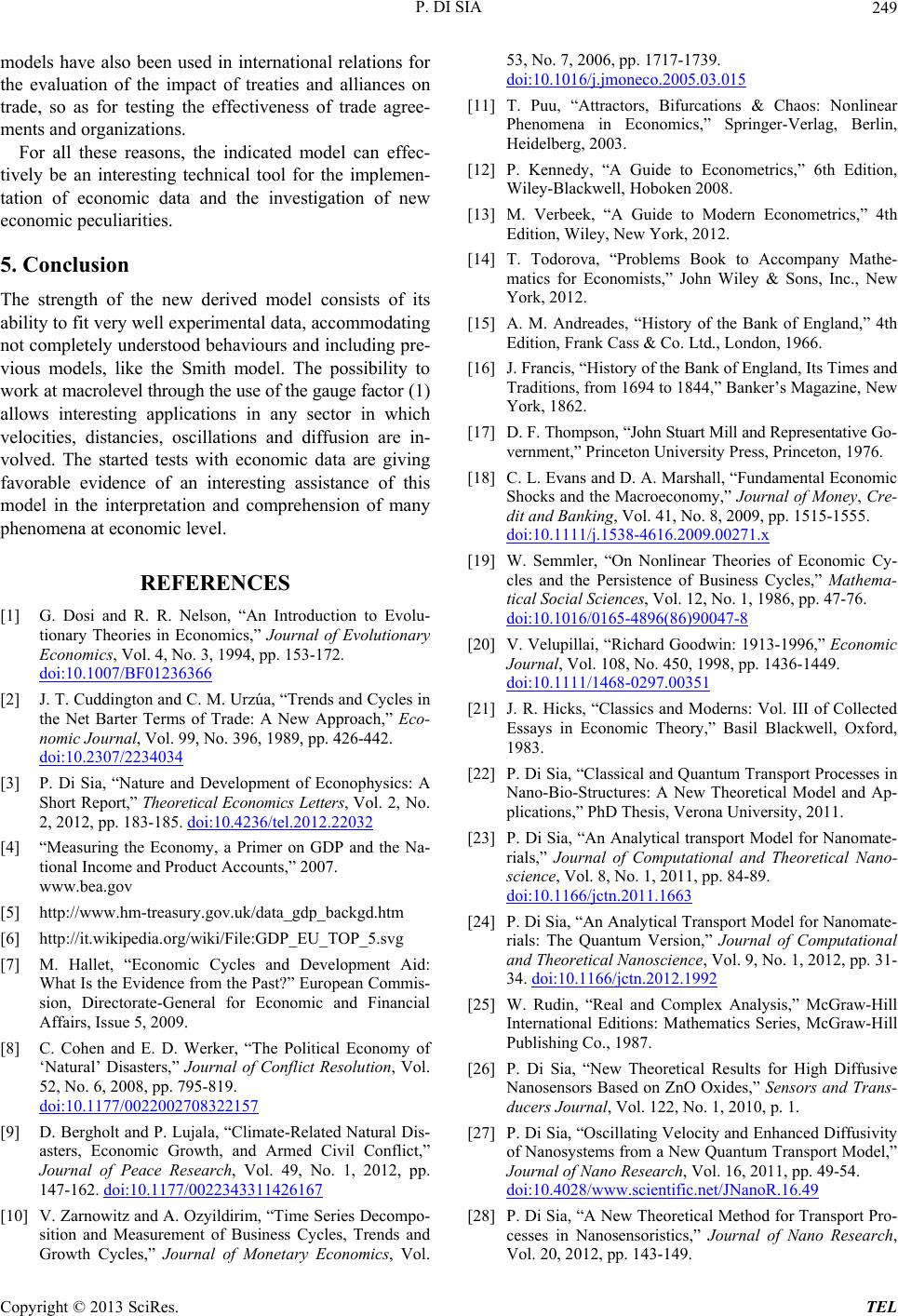
P. DI SIA 249
models have also been used in international relations for
the evaluation of the impact of treaties and alliances on
trade, so as for testing the effectiveness of trade agree-
ments and organizations.
For all these reasons, the indicated model can effec-
tively be an interesting technical tool for the implemen-
tation of economic data and the investigation of new
economic peculiarities.
5. Conclusion
The strength of the new derived model consists of its
ability to fit very well experimental data, accommodating
not completely understood behaviours and including pre-
vious models, like the Smith model. The possibility to
wor k a t macrolevel through the use of the gauge factor ( 1 )
allows interesting applications in any sector in which
velocities, distancies, oscillations and diffusion are in-
volved. The started tests with economic data are giving
favorable evidence of an interesting assistance of this
model in the interpretation and comprehension of many
phenomena at economic level.
REFERENCES
[1] G. Dosi and R. R. Nelson, “An Introduction to Evolu-
tionary Theories in Economics,” Journal of Evolutionary
Economics, Vol. 4, No. 3, 1994, pp. 153-172.
doi:10.1007/BF01236366
[2] J. T. Cuddington and C. M. Urzúa, “Trends and Cycles in
the Net Barter Terms of Trade: A New Approach,” Eco-
nomic Journal, Vol. 99, No. 396, 1989, pp. 426-442.
doi:10.2307/2234034
[3] P. Di Sia, “Nature and Development of Econophysics: A
Short Report,” Theoretical Economics Letters, Vol. 2, No.
2, 2012, pp. 183-185. doi:10.4236/tel.2012.22032
[4] “Measuring the Economy, a Primer on GDP and the Na-
tional Income and Product Accounts,” 2007.
www.bea.gov
[5] http://www.hm-treasury.gov.uk/data_gdp_backgd.htm
[6] http://it.wikipedia.org/wiki/File:GDP_EU_TOP_5.svg
[7] M. Hallet, “Economic Cycles and Development Aid:
What Is the Evidence from the Past?” European Commis-
sion, Directorate-General for Economic and Financial
Affairs, Issue 5, 2009.
[8] C. Cohen and E. D. Werker, “The Political Economy of
‘Natural’ Disasters,” Journal of Conflict Resolution, Vol.
52, No. 6, 2008, pp. 795-819.
doi:10.1177/0022002708322157
[9] D. Bergholt and P. Lujala, “Climate-Related Natural Dis-
asters, Economic Growth, and Armed Civil Conflict,”
Journal of Peace Research, Vol. 49, No. 1, 2012, pp.
147-162. doi:10.1177/0022343311426167
[10] V. Zarnowitz and A. Ozyildirim, “Time Series Decompo-
sition and Measurement of Business Cycles, Trends and
Growth Cycles,” Journal of Monetary Economics, Vol.
53, No. 7, 2006, pp. 1717-1739.
doi:10.1016/j.jmoneco.2005.03.015
[11] T. Puu, “Attractors, Bifurcations & Chaos: Nonlinear
Phenomena in Economics,” Springer-Verlag, Berlin,
Heidelberg, 2003.
[12] P. Kennedy, “A Guide to Econometrics,” 6th Edition,
Wiley-Blackwell, Hoboken 2008.
[13] M. Verbeek, “A Guide to Modern Econometrics,” 4th
Edition, Wiley, New York, 2012.
[14] T. Todorova, “Problems Book to Accompany Mathe-
matics for Economists,” John Wiley & Sons, Inc., New
York, 2012.
[15] A. M. Andreades, “History of the Bank of England,” 4th
Edition, Frank Cass & Co. Ltd., London, 1966.
[16] J. Francis, “History of the Bank of England, Its Times and
Traditions, from 1694 to 1844,” Banker’s Magazine, New
York, 1862.
[17] D. F. Tho mpson, “John Stuart Mill and Repre sentative Go-
vernment,” Princeton University Press, Princeton, 1976.
[18] C. L. Evans and D. A. Marshall, “Fundamental Economic
Shocks and the Macroeconomy,” Journal of Money, Cre-
dit and Banking, Vol. 41, No. 8, 2009, pp. 1515-1555.
doi:10.1111/j.1538-4616.2009.00271.x
[19] W. Semmler, “On Nonlinear Theories of Economic Cy-
cles and the Persistence of Business Cycles,” Mathema-
tical Social Sciences, Vol. 12, No. 1, 1986, pp. 47-76.
doi:10.1016/0165-4896(86)90047-8
[20] V. Velupillai, “Richard Goodwin: 1913-1996,” Economic
Journal, Vol. 108, No. 450, 1998, pp. 1436-1449.
doi:10.1111/1468-0297.00351
[21] J. R. Hicks, “Classics and Moderns: Vol. III of Collected
Essays in Economic Theory,” Basil Blackwell, Oxford,
1983.
[22] P. Di Sia, “Classical and Quantum Transport Processes in
Nano-Bio-Structures: A New Theoretical Model and Ap-
plications,” PhD Thesis, Verona University, 2011.
[23] P. Di Sia, “An Analytical transport Model for Nanomate-
rials,” Journal of Computational and Theoretical Nano-
science, Vol. 8, No. 1, 2011, pp. 84-89.
doi:10.1166/jctn.2011.1663
[24] P. Di Sia, “An Ana lyt ical Transport Model for Nanomate-
rials: The Quantum Version,” Journal of Computational
and Theoretical Nanoscience, Vol. 9, No. 1, 2012, pp. 31-
34. doi:10.1166/jctn.2012.1992
[25] W. Rudin, “Real and Complex Analysis,” McGraw-Hill
International Editions: Mathematics Series, McGraw-Hill
Publishing Co., 1987.
[26] P. Di Sia, “New Theoretical Results for High Diffusive
Nanosensors Based on ZnO Oxides,” Sensors and Trans-
ducers Journal, Vol. 122, No. 1, 2010, p. 1.
[27] P. Di Sia, “Oscillating Velocity and Enhanced Diffusivity
of Nanosyste ms from a New Quantum Transport Model,”
Journal of Nano Research, Vol. 16, 2011, pp. 49-54.
doi:10.4028/www.scientific.net/JNanoR.16.49
[28] P. Di Sia, “A New Theoretical Method for Transport Pro-
cesses in Nanosensoristics,” Journal of Nano Research,
Vol. 20, 2012, pp. 143-149.
Copyright © 2013 SciRes. TEL